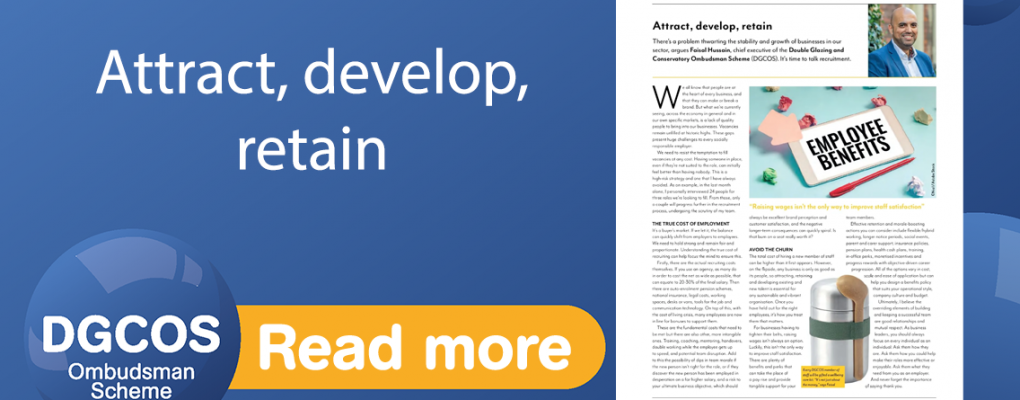In this latest Installer Matters column for GGP Magazine, Faisal Hussain, Chief Executive of the Double Glazing & Conservatory Ombudsman Scheme (DGCOS), tackles a problem that’s currently thwarting the stability and growth of businesses in our sector: recruitment.
We all know that people are at the heart of every business and can make or break a brand. But what we’re currently seeing across the economy in general and our markets specifically, is a lack of quality people to actually bring into our businesses. Vacancies remain unfilled at historic highs. This presents huge challenges to every socially responsible employer. We need to resist the temptation to fill vacancies at any cost, because having ‘someone’ in place, even if they’re not suited to the role, can initially feel better than having nobody. This is a high risk strategy and one that I have always avoided at any cost. As an example, in the last month alone, I personally interviewed 24 people for three roles we’re looking to fill and from those, only a couple will progress further in the recruitment process, undergoing the scrutiny of my team.
The true cost of employment
It’s a buyer’s market, and the shift of balance – if we let it – can quickly shift from employers to employees. This is when we need to hold strong and remain fair and proportionate. Understanding the true cost of recruiting can help focus the mind to ensure this. Firstly, there are the actual recruiting costs themselves and if you use an agency as many do in order to cast the net as wide as possible, that can equate to 20-30% of the final salary. Then there is NI, auto-enrolment pension schemes, legal costs, working spaces, e.g. desks or vans, tools for the job and communication technology. On top of this, with the cost of living crisis, many employees are now in line for bonuses to support them.
These are the fundamental costs that need to be met, but there are also the other more intangible ones. Training, coaching, mentoring, on-the-job training, handovers, double working while the employee gets up to speed and potential team disruption. Add to this the possibility of dips in team morale if the new person isn’t right for the role or if they discover the new person has been employed in desperation on a far higher salary, and a risk to your ultimate business objective which should always be excellent brand perception and customer satisfaction, and the negative longer term consequences can quickly spiral. Is that bum on a seat really worth it?
Avoid the churn
So, the total cost of hiring a new member of staff can be higher than it first appears. However, on the flipside, any business is only as good as its people, so attracting, retaining and developing existing and new talent is essential for any sustainable and vibrant organisation. Having held out for the right employees, it’s then how you treat them that matters.
For businesses having to tighten their belts, raising wages isn’t always an option. Luckily, this isn’t the only way to improve staff satisfaction. There are plenty of benefits and perks that can take the place of a pay rise to provide tangible support for your team members. Effective retention and morale boosting actions you can consider include flexible/hybrid working, longer notice periods, social events, parent and carer support, insurance policies, pension plans, health cash plans, training, in office perks, monetised incentives, and progress rewards with objective driven career progression. All of the options vary in cost, scale, and ease of application, but can help you design a benefits policy that suits your operational style, company culture and budget.
Ultimately, I believe the over-riding elements of building and keeping a successful team are good relationships and mutual respect. As business leaders, you should always focus on every individual as an individual. Ask them how they are. Ask them how you could help make their roles more effective or enjoyable. Ask them what they need from you as an employer. And never forget the importance of saying thank you.
